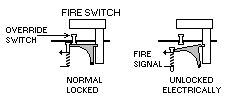Fire Protection - Engines
Engine Fire Protection
Engine Fire Protection consists of these systems:
- Engine Fire and Overheat Detection.
- Engine Fire Warning and Overheat Caution.
- Engine Fire Extinguishing.
Engine Fire and Overheat Detection
There are dual detector loops in each engine nacelle to provide both fire and nacelle overheat detection. In addition, each engine has dual detector loops for:
- Strut Overheat
- Turbine Overheat
Turbine Overheat Detection
Each engine has dual turbine overheat detectors which sense the cooling air from the main bearings and turbine discs. Turbine overheat detection will produce an engine FIRE warning.
Nacelle Overheat Detection
The nacelle overheat detectors are installed behind the precooler air inlets, in the pneumatic ducting area.
Dual Detection Systems
Dual detection is provided to reduce the chance of false warnings. Two detectors located together will both be activated by a fire/overheat. If both detectors are activated the fire warning will operate. If a fault activates one detector it will be displayed as a fault. (i.e. STATUS message) If subsequently, a fire/overheat is sensed the remaining detector will provide the fire warning.
In normal operation, both loops must sense the fire or overheat to activate the fire warnings or overheat cautions. The engine fire loops are continuously monitored for faults. When a fault is detected in one of the loops, the systems reconfigures itself for single loop operation. When the good loop senses a fire/overheat condition, the appropriate fire warnings or overheat cautions activate. If both loops indicate a fault, a fire warning is activated.
The SYSTEM FAIL light illuminates and the EICAS advisory message FIRE/OVHT SYS displays to indicate failure of the fire/overheat detection system. An EICAS status message indicates the inoperative loop. The SYSTEM FAIL light and advisory message can be reset to allow monitoring of the remaining systems.
Strut and Turbine Overheat detectors do not have fault outputs so both loops must generate an overheat signal for the system to activate.
Engine Fire Warning

The indications of an engine fire warning are:
- The fire bell sounds
 .
. - The master WARNING lights illuminate.
- The Engine Fire Switch LEFT or RIGHT fire warning light illuminates.
- The discrete FIRE warning light illuminates.
- The engine FUEL CONTROL switch fire warning light illuminates.
- The EICAS warning message L/R ENGINE FIRE displays.
- The engine fire switch unlocks.
The fire warning lights remain illuminated as long as the fire signal exists. The fire bell may be silenced by any of the following actions:
- Extinguishing the fire.
- Pushing either Master WARNING/CAUTION Reset Switch.
- Pulling the appropriate fire switch.
The fire warning bell rings intermittently for 2 seconds on, then 3 seconds off.
Engine Overheat Caution
The indications of an engine overheat caution are:
- The caution beeper sounds
 .
. - The Master CAUTION lights illuminate.
- The L/R ENG OVHT light illuminates.
- The EICAS caution message L/R ENG OVHT displays.
The overheat lights remain illuminated as long as the overheat condition exists.
Engine Fire Extinguishing
 There are two engine fire extinguisher bottles. Either or both bottles can be discharged into either engine.
There are two engine fire extinguisher bottles. Either or both bottles can be discharged into either engine.
When the fire switch is pulled out:
- the Engine Fuel valves are shutoff
- the Engine Bleed Valves are closed
- the Generator is tripped off
- the Hydraulic fluid is shutoff
- the fire extinguisher is armed
- the fire alarm bell is silenced
- the Thrust Reverser is deactivated
Rotating the fire switch in either direction discharges a single extinguisher bottle into the associated engine. Rotating the engine fire switch in the other direction discharges the remaining extinguisher bottle into the same engine.
If an extinguisher bottle is discharged or has low pressure:
- the ENG BTL 1/2 DISCH light illuminates.
- the EICAS advisory message ENG BTL 1/2 displays.
Engine/APU Fire and Override Switches
 The Engine and APU Fire Switches are mechanically locked in the down position to avoid inadvertent activation. When a fire is detected, the respective switch is electrically unlocked and may then be pulled out. Manual unlocking of the switch is accomplished by pushing the fire override switch located beneath the Fire Switch.
The Engine and APU Fire Switches are mechanically locked in the down position to avoid inadvertent activation. When a fire is detected, the respective switch is electrically unlocked and may then be pulled out. Manual unlocking of the switch is accomplished by pushing the fire override switch located beneath the Fire Switch.